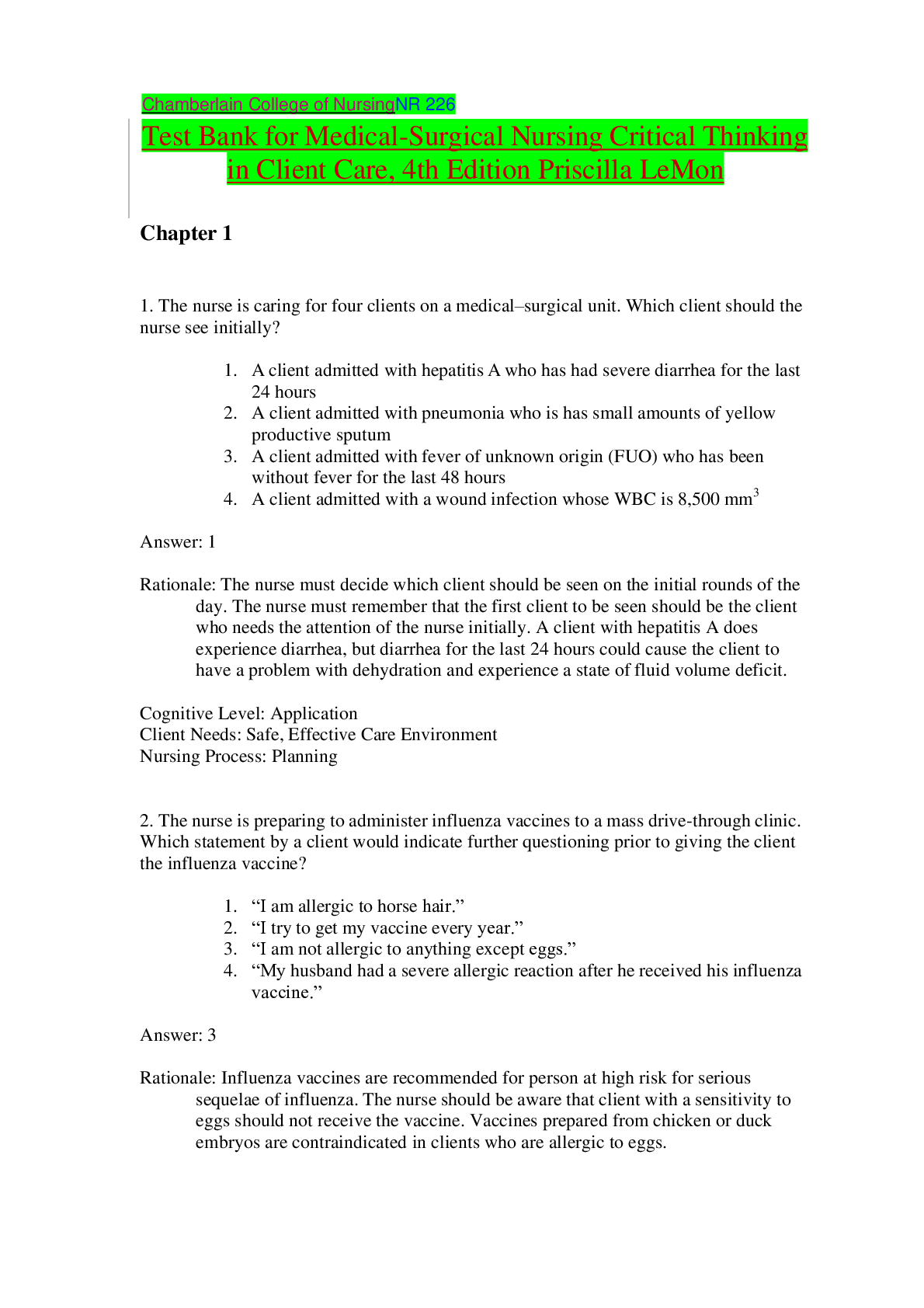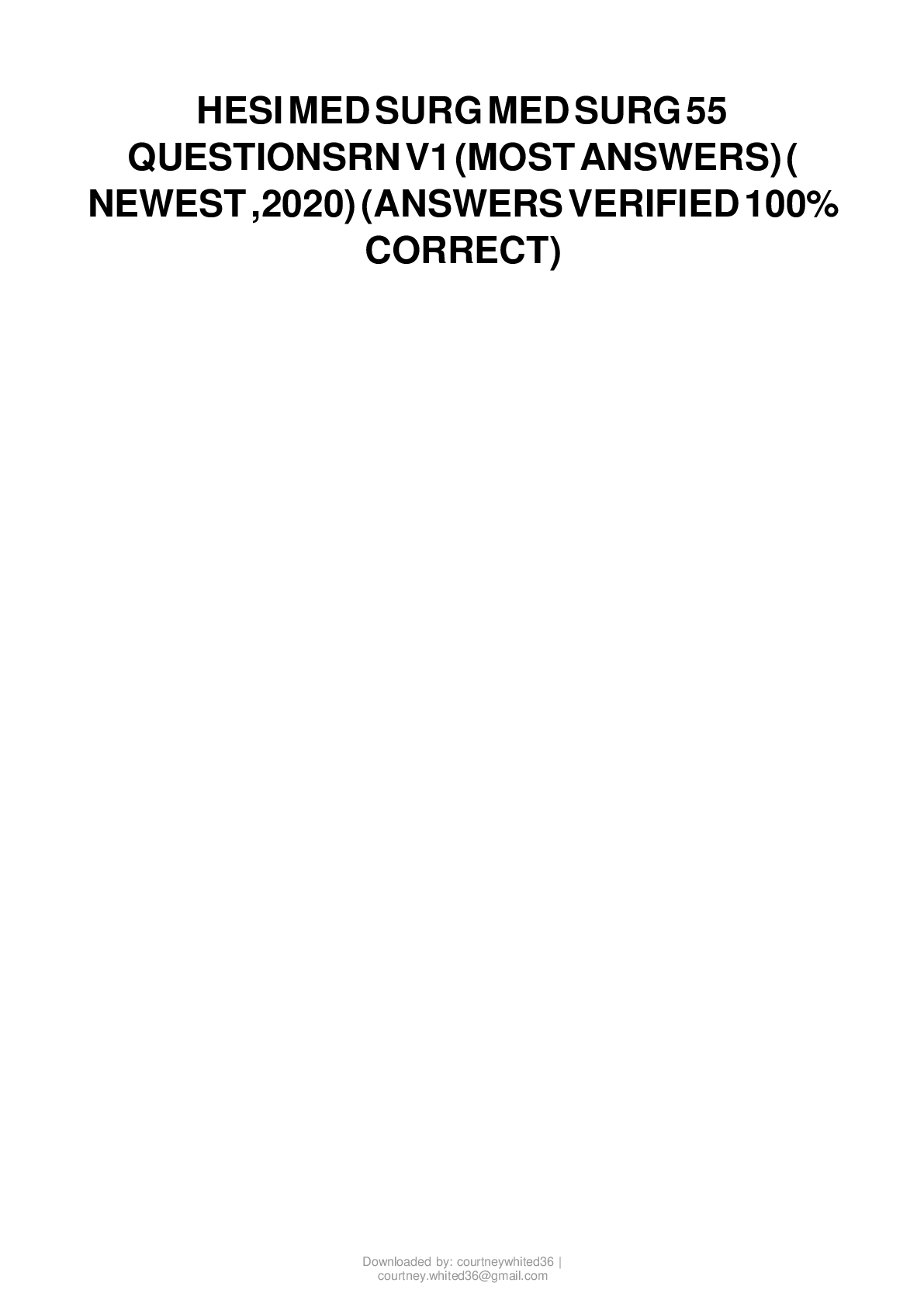Medical Studies > EXAM > MED SURG 250 Test Bank for Medical-Surgical Nursing – Davenport School | MED SURG 250 Critical Thi (All)
MED SURG 250 Test Bank for Medical-Surgical Nursing – Davenport School | MED SURG 250 Critical Thinking in Client Care, 4th Edition
Document Content and Description Below
MED SURG 250 Test Bank for Medical-Surgical Nursing – Davenport School MED SURG 250 Critical Thinking in Client Care, 4th Edition 52 chapters of well answered questions with answers and expanation... s 440+ pages of questions and answers MED SURG 250 Test Bank for Medical-Surgical Nursing Critical Thinking in Client Care, 4th Edition – Davenport School Chapter 1 1. The nurse is caring for four clients on a medical–surgical unit. Which client should the nurse see initially? 1. A client admitted with hepatitis A who has had severe diarrhea for the last 24 hours 2. A client admitted with pneumonia who is has small amounts of yellow productive sputum 3. A client admitted with fever of unknown origin (FUO) who has been without fever for the last 48 hours 4. A client admitted with a wound infection whose WBC is 8,500 mm3 Answer: 1 Rationale: The nurse must decide which client should be seen on the initial rounds of the day. The nurse must remember that the first client to be seen should be the client who needs the attention of the nurse initially. A client with hepatitis A does experience diarrhea, but diarrhea for the last 24 hours could cause the client to have a problem with dehydration and experience a state of fluid volume deficit. Cognitive Level: Application Client Needs: Safe, Effective Care Environment Nursing Process: Planning 2. The nurse is preparing to administer influenza vaccines to a mass drive-through clinic. Which statement by a client would indicate further questioning prior to giving the client the influenza vaccine? 1. “I am allergic to horse hair.” 2. “I try to get my vaccine every year.” 3. “I am not allergic to anything except eggs.” 4. “My husband had a severe allergic reaction after he received his influenza vaccine.” Answer: 3 Rationale: Influenza vaccines are recommended for person at high risk for serious sequelae of influenza. The nurse should be aware that client with a sensitivity to eggs should not receive the vaccine. Vaccines prepared from chicken or duck embryos are contraindicated in clients who are allergic to eggs. Cognitive Level: Application Client Needs: Safe, Effective Care Environment Nursing Process: Assessment 3. The nurse is caring for four clients on a medical–surgical unit. The secretary gives the nurse the morning labs. Which of the following labs would require that the nurse call the physician and inform the healthcare provider about the client’s abnormalities? 1. WBC 14,600 mm3 2. Serum protein 6.9 g/dL 3. I & D (incision and drainage) showing no growth for the last 24 hours 4. Albumin 4.2 g/dL Answer: 1 Rationale: When the nurse is caring for several clients, all of the labs should be checked frequently throughout the shift to assess for any abnormalities. The WBC in option 1 is abnormal. (Normal WBC 4,000–10,000 mm3.) All of the other lab results are within acceptable range; therefore, the results should not be called in to the physician. Cognitive Level: Application Client Needs: Physiologic Integrity Nursing Process: Assessment 4. The nurse is orienting a new graduate. The nurse is reinforcing the importance of standard precautions. Which of the following observations by the nurse would require further education regarding standard precautions? 1. The graduate nurse understands to wash hands when entering and exiting the client’s room. 2. The graduate nurse wears gloves when serving breakfast trays to various clients. 3. The graduate nurse wears a gown, gloves, and goggles when suctioning a client. 4. The graduate nurse leaves all supplies in the room of a client who is in contact isolation. Answer: 2 Rationale: The nurse must have an understanding of standard precautions. Prevention is the most important measure to prevent nosocomial infections. Standard precautions were published in 1996 that provide guidelines for the handling of blood and other body fluids. These guidelines are used with all clients, regardless of whether they have a known infectious disease. Standard precautions are used by all healthcare workers who have direct contact with clients or with their body fluids. It is not necessary for the nurse to wear gloves while delivering food trays to the client, because there is not contact with the client. Cognitive Level: Application Client Needs: Safe, Effective Care Environment Nursing Process: Evaluation 5. The admitting department alerts the nurse on a medical–surgical unit that a client with active tuberculosis (TB) is being admitted to the unit. Which type of isolation is appropriate based on the client’s diagnosis? 1. Standard precautions 2. Airborne precautions 3. Droplet precautions 4. Contact precautions Answer: 2 In addition to handwashing and standard precautions, the nature and spread of some infectious diseases require that special techniques be used to protect uninfected clients and workers. The client with pulmonary tuberculosis will be placed in airborne precautions. The client should be placed in a private room with special ventilation that does not allow air to circulate to general hospital ventilation; a mask or special filter respirators will be used for everyone entering the room. Cognitive Level: Application Client Needs: Safe, Effective Care Environment Nursing Process: Assessment 6. A client is receiving IV vancomycin for the treatment of Clostridium difficile. The nurse understands that the client who develops flushing, tachycardia, and hypotension during the infusion of vancomycin indicates: 1. Ototoxicity effect. 2. Superinfection. 3. Red man syndrome. 4. Hives. Answer: 3 Rationale: Vancomycin inhibits cell wall synthesis, and is used for serious infections. It is only effective against gram-positive bacteria, especially Staphylococcus aureus and Staphylococcus epidermidis. The nurse should infuse this medication slowly over 60 minutes or more to avoid “red man” syndrome. The syndrome is characterized by erythematous rash, flushing, tachycardia, and hypotension. Clients can become dizzy and agitated. Cognitive Level: Application Client Needs: Physiological Integrity Nursing Process: Evaluation 7. The physician has ordered for the client to receive a trough blood level to evaluate the therapeutic effect of an antibiotic. The nurse understands that the trough should be ordered: 1. A few minutes before the next scheduled dose of medication. 2. 1–2 hours after the oral administration of the medication. 3. 30 minutes after the IV administration. 4. During the infusion of the antibiotic. Answer: 1 Rationale: Antibiotic peak and trough levels monitor therapeutic blood levels of the prescribed medication. The therapeutic range—the minimum and maximum blood levels at which the drug is effective—is known for a given drug. By measuring blood levels at the predicted peak (1–2 hours after oral administration, 1 hour after intramuscular administration, and 30 minutes after IV administration) and trough (usually a few minutes before the next scheduled dose), it is also possible to determine whether the drug is reaching a toxic or harmful level during therapy, increasing the likelihood of adverse effects. Cognitive Level: Application Client Needs: Safe, Effective Care Environment Nursing Process: Assessment 8. The nurse needs to change a dressing on the client’s abdomen. Which of the following techniques should be implemented? 1. Contact precautions 2. Standard precautions 3. Droplet precautions 4. Airborne precautions Answer: 2 Rationale: Standard precautions are used on all clients, regardless of whether they have a know infectious disease. Standard precautions are used by all healthcare workers who have direct contact with clients or with their body fluids. Since the client has an abdominal dressing, the nurse will use standard precautions. Cognitive Level: Application Client Needs: Safe, Effective Care Environment Nursing Process: Planning 9. The physician has ordered for the nurse to obtain a sputum specimen. The nurse understands that the sputum specimen should be collected: 1. Immediately after the first dose of antibiotic is administered. 2. 30 minutes after the first dose of antibiotics is administered. 3. During the first dose of antibiotics. 4. Before the first dose of antibiotics is administered. Answer: 4 Rationale: When the physician orders a specimen to be collected, the nurse should collect the specimen before the first dose of antibiotics is administered, to ensure adequate organisms for culture. Cognitive Level: Comprehension Client Needs: Safe, Effective Care Environment Nursing Process: Planning 10. Which of the following manifestations indicates a systemic reaction associated with an inflammatory response? 1. Erythema 2. Pain 3. Tachypnea (RR 26) 4. Edema Answer: 3 Rationale: If the nurse observes a systemic reaction, the client will exhibit manifestations including temperature, increased pulse, tachypnea, and leukocytosis. Erythema, warmth, pain, edema, and functional impairment indicate a local reaction. Cognitive Level: Application Client Needs: Physiological Integrity Nursing Process: Assessment 11. A client develops hyperthermia related to a diagnosis of Pneumonia. Which of the following nursing interventions would be effective in the treatment of hyperthermia? Select all that apply. 1. Increase the temperature of the room environment to prevent shivering. 2. Use ice packs and a tepid bath as needed. 3. Administer antipyretic medications per physician’s orders. 4. Promote frequent rest periods to increase energy reserve. 5. Restrict fluids during periods of hyperthermia because of the risk of electrolyte imbalance. Answer: 2; 3; 4 Rationale: Hyperthemia is an expected consequence of the infectious disease process. Fever can produce mild, short-term effects or, when prolonged, can cause life-threatening effects. The nurse should administer antipyretic medications as indicated for elevated temperatures. The nurse should use ice packs, cool/tepid baths, or hypothermia blanket with caution. The nurse should enforce frequent rest periods because rest increases energy reserve, which is depleted by an increased metabolic, heart, and respiratory rate. The nurse should encourage fluids rather than restrict fluids because of the risk of electrolyte imbalance. Cognitive Level: Assessment Client Needs: Physiological Integrity Nursing Process: Implementation 12. The nurse is assessing a client’s wound for signs and symptoms of inflammation. Which of the following would alert the nurse that the client is exhibiting signs of inflammation? Select all that apply. 1. Leg edema 2. Leg cool to touch 3. Severe pain from swelling 4. Decreased peripheral pulses 5. Severe erythema of leg Answer: 1; 3; 5 Rationale: Regardless of the cause, location, or extent of the injury, the acute inflammatory response follows the sequence of vascular response, cellular and phagocytic response, and healing. Many manifestations of inflammation are produced by inflammatory mediators such as histamines and prostaglandins released when tissue is damaged. The cardinal signs of inflammation include erythema, local heat caused by the increased blood flow to the injured area (hyperemia), swelling due to accumulated fluid at site, pain from tissue swelling and chemical irritation of nerve endings, and loss of function caused by the swelling and pain. Cognitive Level: Application Client Needs: Physiological Integrity Nursing Process: Assessment Alternate item format – Select all that apply Which of the following manifestations would the nurse expect to see with a client who has had previous knee surgery who suffered a surgical infection with signs of systemic manifestations? Select all that apply. 1. Erythema 2. WBC 14,200 mm3 3. Pain at the surgical site 4. 10% Bands 5. Respiratory rate of 16 6. Pulse 114 Answer: 2; 3; 6 Rationale: The client is post–surgical repair of the knee. The nurse should be able to distinguish between local reactions and system reactions. An elevated WBC and 10% bands are indicative of an infection. Vital sign changes typically associated with an infection include an elevation in temperature and tachycardia. Local manifestations include erythema, warmth, pain, edema, and functional impairment, whereas systemic manifestations include elevated temperature above 100.4°F, pulse greater than 90/min., respiratory rate greater than 20, and WBC greater than 12,000 mm3 or > 10% bands. Cognitive Level: Application Client Needs: Physiological Integrity Nursing Process: Assessment Chapter 2 1. When collecting data at the immunization clinic, which of the following disclosures by the client would cause the nurse to hold administration of the varicella vaccine? a. History of an allergic reaction to yeast bread b. Itching and swelling on the face and hands after ingesting eggs c. A low grade temperature within the past two days d. A blood transfusion after undergoing surgery three months ago Answer: d Rationale: Contradictions for the varicella vaccine include pregnancy, suppressed immunity, and a recent history of a blood transfusion. Recent hyperthermia and allergies to yeast or eggs do not indicate a potential difficulty with the administration of the varicella vaccine. Nursing Process Step: Assessment Client Needs Category: Health Promotion and Maintenance Client Needs Subcategory: Prevention and/or Early Detection of Health Problems Cognitive Level: Analysis 2. The nurse is planning an in-service to discuss primary levels of disease prevention. Which of the following topics should be included in this presentation? a. A discussion concerning the use of available community rehabilitation facilities b. Available locations for diabetes screening c. The need for annual colonoscopy examinations d. The elimination of smoking and alcohol use Answer: d Rationale: Primary prevention involves activities geared toward the prevention of illness and disease. Screening activities such as glucose testing and colonoscopy examinations are a form of secondary prevention. Rehabilitation activities are considered a tertiary level of prevention. Nursing Process Step: Planning Client Needs Category: Health Promotion and Maintenance Client Needs Category: Prevention and/or Early Detection of Health Problems Cognitive Level: Application 3. A 45-year-old client voices concerns about gaining 12 pounds over the past two years. The client reports no change in dietary habits. Which response by the nurse is most appropriate? a. “Age-related changes in metabolism can result in weight gain despite consistent dietary intake.” b. “Are you exercising?” c. “You might be eating more than you think.” d. “You are getting older.” Answer: a Rationale: A reduction in metabolic rate often accompanies aging. This will cause weight gain despite not eating more calories. Asking the client about exercise fails to provide the needed information to the client. It also assumes the client is sedentary. Implying the client is overeating is judgmental, and will do little to establish a therapeutic rapport. The client is aware of aging. Pointing this out does little to meet the client’s obvious interest in more information. Nursing Process Step: Diagnosis Client Needs Category: Physiological Integrity Client Needs Category: Physiological Adaptation Cognitive Level: Application 4. The nurse is assisting an 18-year-old female client to plan a healthy diet to support recent weight loss. Which of the following should be included in the dietary plan? Select all that apply. a. 200 mg folic acid are recommend in the daily diet. b. Eat at least six servings of grains. c. To avoid constipation, keep daily iron intake below 21 mg. d. Fat intake should be limited to less than 30% of the daily caloric intake. Answer: b; d Rationale: Grain intake should include at least six servings daily. To maintain a healthy weight and reduce incidence of cardiovascular disease, fat intake should not exceed 30% of the daily intake. Folic acid intake should be at 400 mg daily. Iron is a vital ingredient in the daily diet. 18 mg daily is reflective of the desired amount. Constipation should be managed by an adequate fluid and fiber intake. Nursing Process Step: Planning Client Needs Category: Health Promotion and Maintenance Client Needs Subcategory: Prevention and/or Detection of Early Health Problems Cognitive Level: Application 5. During a routine physical examination for a 52-year-old Caucasian male, the client declines to have his prostate gland examined. He states he does not have a family history and does not feel he is at risk. What initial response by the nurse is most appropriate? a. “You may refuse any screening test you wish.” b. “I will need to tell the physician about your refusal.” c. “Your risk factors increase with aging.” d. “You are right, Caucasian men have less incidence of prostate cancer.” Answer: c Rationale: The need for prostate screening begins at age 50. Individuals with risk factors should begin screening at age 45. The client’s age places him at an increased risk, so he should begin the screening process. While the client may refuse any testing, this does not allow the client to engage in secondary levels of prevention. The client’s refusal should be recorded in the medical record but not used as a means to coerce the client. Nursing Process Step: Implementation Client Needs Category: Health Promotion and Maintenance Client Needs Subcategory: Growth and Development through the Lifespan Cognitive Level: Analysis 6. The nurse is preparing to teach a class for a group of new parents. The nurse is attempting to determine what topic would be of the greatest interest to the audience. What selection would be most appropriate? a. Safety b. Chronic illness prevention c. Problem-solving skills d. Interventions to manage depression Answer: a Rationale: The parents of small children are interested in information geared toward keeping them safe. Household safety is a priority for children of all ages. The families attending the session likely will have limited interest in preventing illness, as they typically represent a healthy segment of the population. Depression is a greater concern for older adults. Nursing Process Step: Assessment Client Needs Category: Health Promotion and Maintenance Client Needs Subcategory: Growth and Development through the Lifespan Cognitive Level: Analysis 7. An African-American male is discussing his dietary intake with the nurse. The nurse encourages the client to keep sodium intake below 1,500 mg per day. The client reports he does not have any known risk for the development of hypertension and feels this is too restrictive. How should the nurse respond? a. “African-Americans typically have higher sodium levels than their Caucasian counterparts.” b. “This is the amount of sodium intake recommended for everyone.” c. “This is what will be best for you.” d. “Do you eat a great deal of salt?” Answer: a Rationale: After generations of conditioning, African-Americans frequently have higher sodium levels. The recommended sodium intake for African-Americans is slightly lower than are the levels for their Caucasian peers. Simply telling the client the recommendation is “best” does not provide an adequate level of information. The amount of salt ingested by the client should be recorded, but this is not the best response. Nursing Process Step: Implementation Client Needs Category: Physiological Integrity Client Needs Subcategory: Physiological Adaptation Cognitive Level: Analysis 8. A 45-year-old woman presents to the ambulatory clinic for a gynecological examination. The health history reveals no significant personal or family medical history. What information concerning health-promotion behaviors should be presented to the client? a. It is time to begin having mammograms every other year. b. If the client is in a monogamous relationship, Pap smears will not be needed. c. Bone density examinations are indicated every year. d. Recommended calcium intake is at least 1,200 mg per day. Answer: d Rationale: The recommended calcium intake is at least 1,200 mg per day. This will be beneficial in the prevention of osteoporosis. Women should begin having annual mammograms by age 40. Pap smears are continued for women in monogamous relationships. For women with no significant risk for the development of osteoporosis, bone density examinations should be done every other year. Nursing Process Step: Implementation Client Needs Category: Health Promotion and Maintenance Client Needs Subcategory: Prevention and/or Early Detection of Health Problems Cognitive Level: Analysis 9. A 75-year-old client seeks care at an ambulatory clinic. The client reports having experienced extreme drowsiness after recently taking dosages of an over-the-counter cold medication. When collecting data, the nurse notes the client reports taking only the prescribed amount of the preparation. What inferences can be made by the nurse concerning the events? a. The client likely has taken more of the preparation than stated. b. The client likely has experienced a reaction between the cold medication and other routine medications. c. The client’s age has influenced his response to the medication. d. The client is allergic to the cold medication. Answer: c Rationale: Older clients often experience altered responses to medications. These changes are in response to age-related developments in the kidneys and liver. There is no evidence the client has taken too much medication. There is no information provided to indicate the client is taking other medications. Allergic reactions typically manifest with integumentary- or respiratory-related symptoms. Nursing Process Step: Evaluation Client Needs Category: Physiological Integrity Client Needs Subcategory: Pharmacological and Parental Therapies Cognitive Level: Analysis - - - - - - - - - - - - - - - - - - - - - - - - - CHAPTER 51 1. A 41-year-old client has reported to the clinic with clinical manifestations consistent with menopause. The client states that her menstrual periods have become irregular, with the last period occurring approximately four months ago. What information should be provided to the client concerning the use of contraceptives? a. Contraceptives should continue to be utilized. b. Contraceptives are no longer needed. c. Contraceptives will only be needed in the months after menstruation is experienced. d. Contraceptive use will only be needed for another two months. Answer: a Rationale: It takes approximately one year of menstrual cycle cessation in order for a woman to be considered in menopause. It is still possible for the woman to become pregnant during this period of time. NURSING PROCESS STEP: Implementation CLIENT NEEDS CATEGORY: Health Promotion and Maintenance CLIENT NEEDS SUBCATEGORY: Prevention and/or Early Detection of Health Problems COGNITIVE LEVEL: Application 2. The client who has been experiencing the clinical manifestations associated with menopause voices an interest in using alternative and complementary therapies to manage them. What initial response by the nurse is indicated? a. “Those seldom work.” b. “Many women report success with these measures.” c. “What types of therapies are of interest to you?” d. “Have you discussed this with the physician? Answer: c Rationale: Alternative and complementary therapies are used by many women to manage the manifestations associated with menopause. The nurse has a responsibility to collect data from the client. The nurse will need to determine which types of therapies are of interest to the client. The success of these remedies varies by user. It is inappropriate for the nurse to meet the client’s request with negativity. Clients using alternative therapies are asked to report them to their physicians. This is not, however, the initial step for this scenario. NURSING PROCESS STEP: Implementation CLIENT NEEDS CATEGORY: Health Promotion and Maintenance CLIENT NEEDS SUBCATEGORY: Prevention and/or Early Detection of Health Problems COGNITIVE LEVEL: Application 3. During the teaching session for a client who recently had a hysterectomy, the client states that she is nervous about taking the estrogen replacement therapy prescribed by her physician. She states that she is worried about developing breast cancer later in life. Which of the statements by the nurses will be most appropriate? a. “The risk of breast cancer is somewhat increased for women with a family history who opt to take estrogen replacement therapy.” b. “The risk of breast cancer is not increased for women who have had a hysterectomy and take estrogen replacement medications.” c. “Perhaps you should consider an estrogen–progestin combination therapy.” d. “Taking estrogen replacement is not required after a hysterectomy.” Answer: b Rationale: The risk for the development of breast cancer is not greater for women who take estrogen replacement therapy after undergoing a hysterectomy. Progestin therapies are not used for women who are in surgical menopause. Further, it is inappropriate for the nurse to make suggestions of a prescriptive nature, as it violates the scope of practice. While it is not mandatory for the client to take estrogen replacement therapy after surgery, the nurse should clarify and correct misconceptions of the client. NURSING PROCESS STEP: Implementation CLIENT NEEDS CATEGORY: Physiological Integrity CLIENT NEEDS SUBCATEGORY: Pharmacological and Parenteral Therapies COGNITIVE LEVEL: Application 4. A 30-year-old woman reports increasing difficulty during the days preceding the onset of her menstrual cycle. Which of the following might assist in the management of her condition? Select all that apply. a. Increase dietary sugar intake to promote energy. b. Increase intake of simple carbohydrates. c. Reduce caffeine. d. Utilize guided imagery. Answers: c; d Rationale: A reduction in caffeine intake is indicated to reduce irritability. Guided imagery can be used to reduce stress and promote relaxation. Dietary intake can be modified to aid in the management of premenstrual syndrome. Simple carbohydrates and sugars are reduced. NURSING PROCESS STEP: Planning CLIENT NEEDS CATEGORY: Health Promotion and Maintenance CLIENT NEEDS SUBCATEGORY: Prevention and/or Early Detection of Health Problems COGNITIVE LEVEL: Application 5. A client who has been experiencing premenstrual syndrome reports to the clinic with a diet diary she has kept over the past several weeks. Which of the following findings should be reviewed with the client, with a recommendation made for dietary modification? a. Daily intake of caffeine-free soda b. Daily intake of low-fat yogurt c. Foods rich in magnesium d. Daily intake of white bread Answer: d Rationale: Dietary intake of simple carbohydrates should be reduced. White bread should be traded for whole-wheat bread if possible. Dietary adjustments of reduced caffeine and increased calcium and magnesium are beneficial in the management of premenstrual syndrome. NURSING PROCESS STEP: Evaluation CLIENT NEEDS CATEGORY: Health Promotion and Maintenance CLIENT NEEDS SUBCATEGORY: Prevention and/or Early Detection of Health Problems COGNITIVE LEVEL: Analysis 6. A woman is scheduled to undergo a laparoscopic procedure. Which of the following statements by the client indicates the need for further education? a. “I can expect to go home a few hours after the procedure.” b. “I might experience some abdominal pain after the procedure.” c. “There might be some vaginal bleeding after the procedure.” d. “Shoulder pain should be reported, as it might signal a complication.” Answer: d Rationale: The presence of shoulder pain is anticipated after laparoscopic procedures. The discomfort is a result of the air injected into the abdominal cavity to promote visualization during the procedure. NURSING PROCESS STEP: Evaluation CLIENT NEEDS CATEGORY: Physiological Integrity CLIENT NEEDS SUBCATEGORY: Physiological Adaptation COGNITIVE LEVEL: Analysis 7. A 13-year-old female reports to the school nurse with concerns about her menstrual cycle. The client states that she has not yet started her period, and asks if this is normal. Which of the following should be included in the nurse’s response? a. The client should be referred to a gynecologist for a pelvic examination. b. The client should have started her period by now. c. It is not abnormal for the client to have not yet started her period. d. The client should be tested for hormonal imbalances. Answer: c Rationale: The average age of onset for menarche is 12.8 years. The absence of menarche at the age of 13 is not a reason for concern. It is premature for the client to be examined or have testing for a hormonal imbalance. NURSING PROCESS STEP: Planning CLIENT NEEDS CATEGORY: Health Promotion and Maintenance CLIENT NEEDS SUBCATEGORY: Growth and Development Through the Life span COGNITIVE LEVEL: Application 8. The nurse is collecting data during a routine clinic visit. The client reports she has experienced bleeding between her menstrual periods. What initial action by the nurse is most appropriate? a. Determine the timing of the bleeding episodes. b. Determine the amount of the bleeding episodes. c. Assess for the presence of sexually transmitted infections. d. Review the length of the client’s normal menstrual cycles. Answer: a Rationale: Bleeding between menstrual cycles could have several causes. Bleeding can be a result of midcycle ovulation, and normal. It is most important to identify the timing of the bleeding to determine the underlying cause. Assessment of the amount of bleeding is next in importance. There is no indication the client has sexually transmitted infections. The length of the client’s menstrual cycle is a part of the data collection process, but is not of the greatest importance. NURSING PROCESS STEP: Assessment CLIENT NEEDS CATEGORY: Physiological Integrity CLIENT NEEDS SUBCATEGORY: Physiological Adaptation COGNITIVE LEVEL: Analysis 9. A client has been experiencing anovulatory dysfunctional uterine bleeding. The client is 25 years of age, and is concerned about maintaining her fertility. Based upon your knowledge, which management technique likely would be employed first? a. Oral contraceptives b. Progestin therapy c. Therapeutic D and C d. Endometrial ablation Answer: a Rationale: Oral contraceptives can be used to regulate uterine bleeding in women when the bleeding is anovulatory. Progestin therapy can be used to treat ovulatory uterine bleeding. The therapeutic D and C would not be an initial therapy for condition. Endometrial ablation would destroy the client’s fertility. NURSING PROCESS STEP: Implementation CLIENT NEEDS CATEGORY: Health Promotion and Maintenance CLIENT NEEDS SUBCATEGORY: Prevention and/or Early Detection of Health Problems COGNITIVE LEVEL: Application 10. A client is preparing to be discharged to home after a hysterectomy. Which of the following statements by the client indicates the teaching session has been successful? a. “I will need to report temperature greater than 101 degrees.” b. “I might experience vaginal bleeding for about one week.” c. “I will need to report any hot flashes, as they indicate my hormone replacement therapy is not effective.” d. “I will still need to see my physician for gynecological examinations.” Answer: d Rationale: The client who has had a hysterectomy still will need to have gynecological examinations. The client should be advised to seek medical advice if a temperature greater than 100°F is encountered. Vaginal bleeding after hysterectomy can last up to four weeks. The client who has a hysterectomy with the loss of the ovaries will immediately begin surgical menopause. The loss of estrogen is immediate. The hormone replacement therapy will take time to begin to manage the clinical manifestations associated with menopause. NURSING PROCESS STEP: Evaluation CLIENT NEEDS CATEGORY: Physiological Integrity CLIENT NEEDS SUBCATEGORY: Reduction of Risk Potential COGNITIVE LEVEL: Application Chapter 52 1. A client recently diagnosed with herpes simplex II asks how to best manage the lesions. What information should be given to the client? a. The use of soap should be restricted. b. It is safe to use a solution of 50% rubbing alcohol and 50% water to clean the lesions. c. Wearing nylon panties will reduce discomfort. d. Gentle soap and water can be used to clean the lesions. Answer: d Rationale: The lesions need to be kept clean and dry. It is safe to use mild soap and water. Rubbing alcohol would cause burning of the lesions, and should not be used. Nylon panties will promote moisture and reduce ventilation to the perineal area. NURSING PROCESS STEP: Implementation CLIENT NEEDS CATEGORY: Health Promotion and Maintenance CLIENT NEEDS SUBCATEGORY: Prevention and/or Early Detection of Health Problems COGNITIVE LEVEL: Application 2. A client recently treated for pelvic inflammatory disease asks how she can best prevent a recurrence of the disease. What information should be provided to the client? a. The physician will prescribe prophylactic antibiotic therapy. b. The use of condoms will be beneficial. c. Annual gynecological examinations should be scheduled. d. Douching after intercourse will assist in removing potential pathogens from the genital area. Answer: b Rationale: Condoms provide a barrier from the introduction of pathogens to the woman’s body. Prophylactic antibiotics are not used to manage pelvic inflammatory disease. Annual gynecological examinations are recommended, but will not prevent the spread of the disease. Douching can actually increase the incidence of pelvic inflammatory disease. Douching will force fluids higher into the woman’s vagina and cervical area. NURSING PROCESS STEP: Planning CLIENT NEEDS CATEGORY: Health Promotion and Maintenance CLIENT NEEDS SUBCATEGORY: Prevention and/or Early Detection of Health Problems COGNITIVE LEVEL: Application 3. A client treated for pelvic inflammatory disease is preparing for discharge. During the teaching session, the use of tampons is discussed. Which of the following statements by the client indicate the understanding of the content provided? Select all that apply. a. “I will be able to wear tampons.” b. “The use of tampons is forever prohibited.” c. “Tampons must be changed at least every four hours.” d. “I should wear pads at night.” Answers: a; c; d Rationale: The use of tampons is allowed. Clients using tampons must remember to change them regularly. Wearing pads at night will ensure the tampons are not left in too long while the client sleeps. NURSING PROCESS STEP: Evaluation CLIENT NEEDS CATEGORY: Physiological Integrity CLIENT NEEDS SUBCATEGORY: Reduction of Risks Potential COGNITIVE LEVEL: Application 4. A pregnant client reports to the clinic and learns she has tested positive for herpes simplex. The nurse develops a plan of care. Which of the following nursing diagnoses has the highest priority? a. Injury, Risk for related to the disease process b. Knowledge, Deficient related to the diagnosis c. Anxiety related the diagnosis d. Family Processes, Interrupted related to the effects of the diagnosis on her relationship with her partner Answer: a Rationale: All of the presented nursing diagnoses are of importance to the client. The client’s greatest risk is related to the potential for complications from the herpes simplex. Once the risk of injury is addressed, the diagnosis of next greatest importance involves the knowledge deficit. Anxiety and interrupted family processes can be managed after the client’s risk for injury and knowledge deficit are managed. NURSING PROCESS STEP: Diagnosis CLIENT NEEDS CATEGORY: Safe, Effective Care Environment CLIENT NEEDS SUBCATEGORY: Management of Care COGNITIVE LEVEL: Analysis 5. A client has been diagnosed with latent syphilis. During the counseling session, the client asks about transmitting the disease to his spouse. What information should be provided to the client? a. “You will need to abstain from sexual relations until treatment is completed.” b. “You will need to wear a condom.” c. “At this late stage, the disease is contained to only you.” d. “At this stage of the disease, transmission is by contact with blood.” Answer: d Rationale: During latent syphilis, the disease is transmitted by exposure to contaminated blood. Sexual contact will not transmit the disease. NURSING PROCESS STEP: Implementation CLIENT NEEDS CATEGORY: Safe, Effective Care Environment CLIENT NEEDS SUBCATEGORY: Safety and Infection Control COGNITIVE LEVEL: Analysis 6. During a gynecological examination and testing, a female client is diagnosed with a Chlamydial infection. The client denies any symptoms of the disease, and asks when she contracted the disease. What information should be provided to the client? a. The client has most likely had the infection for about 1–3 weeks. b. The infection has been in her body for less than 1 month, since no symptoms are present. c. The infection might have been in her body for an indefinite period of time. d. Symptoms typically begin a few months after the infection enters the body. Answer: c Rationale: The infection can be asymptomatic in the woman’s body for months or years before symptoms are produced. The incubation period for the disease is 1–3 weeks. NURSING PROCESS STEP: Implementation CLIENT NEEDS CATEGORY: Physiological Integrity CLIENT NEEDS SUBCATEGORY: Physiological Adaptation COGNITIVE LEVEL: Application 7. The nurse is planning to teach a course about sexually transmitted infections. What information concerning genital warts should be included? a. Handwashing will aid in the reducing the spread of genital warts. b. Genital warts will result in cervical cancer for the majority of women who get them. c. Women who have certain types of genital warts should be vaccinated against other types. d. The risk for the development of penile cancer is high in men diagnosed with genital warts. Answer: a Rationale: Handwashing is the first line of defense for the body against disease. A select number of disease strains are implicated in causing cervical cancer. The vaccine against the virus is limited to those individuals who do not have the disease. The rate of penile cancer is not overly high in men who have been diagnosed with genital warts. NURSING PROCESS STEP: Implementation CLIENT NEEDS CATEGORY: Health Promotion and Maintenance CLIENT NEEDS SUBCATEGORY: Prevention and/or Early Detection of Health Problems COGNITIVE LEVEL: Application 8. A client asks which method of contraception will provide the greatest protection against sexually transmitted infections. What method can the nurse recommend? a. Oral contraceptives b. Male condoms c. Sponges d. Spermicides Answer: b Rationale: The condom will provide a barrier against pathogens. Oral contraceptives contain hormones, and will not impact resistance to sexually transmitted infections. Sponges and spermicides contain chemicals to kill sperm. These chemicals alone do not provide protection from disease. NURSING PROCESS STEP: Implementation CLIENT NEEDS CATEGORY: Health Promotion and Maintenance CLIENT NEEDS SUBCATEGORY: Prevention and/or Early Detection of Health Problems COGNITIVE LEVEL: Application 9. A client reports to the clinic with a painless, ulcerated area on her labia. Based upon your knowledge, what diagnosis do you anticipate? a. Herpes simplex II b. Syphilis c. Condylomata acuminata d. Gonorrhea Answer: b Rationale: Painless ulcerations are indicative of syphilis. Herpes simplex II infection will present with a painful ulceration. Condylomata acuminata appear as fleshy growths in which the skin is intact. Gonorrhea infections manifest with dysuria or discharge. NURSING PROCESS STEP: Diagnosis CLIENT NEEDS CATEGORY: Physiological Integrity CLIENT NEEDS SUBCATEGORY: Physiological Adaptation COGNITIVE LEVEL: Application 10. A client with herpes simplex II is concerned about sexual relations. What information should be provided to the client? a. The infection can be transmitted only when the lesions present. b. The infection can be prevented with condom use. c. Sexual relations must be avoided during the prodromal period and for at least 10 days after the lesions are healed. d. Sexual activity is permissible once the lesions have dried out. Answer: c Rationale: The herpes simplex virus can be transmitted during the prodromal period and for approximately 10 days after the lesions have healed. During these periods, sexual activity should be avoided. During the prodromal period, lesions are not present, but it is believed the virus is shed, making transmission possible. Condom use is beneficial in protection against the disease, but it is not 100%. Viral shedding is limited after the lesions have healed, but this is not the only period of potential transmission. NURSING PROCESS STEP: Implementation CLIENT NEEDS CATEGORY: Health Promotion and Maintenance CLIENT NEEDS SUBCATEGORY: Prevention and/or Early Detection of Health Problems COGNITIVE LEVEL: Analysis [Show More]
Last updated: 2 years ago
Preview 1 out of 443 pages
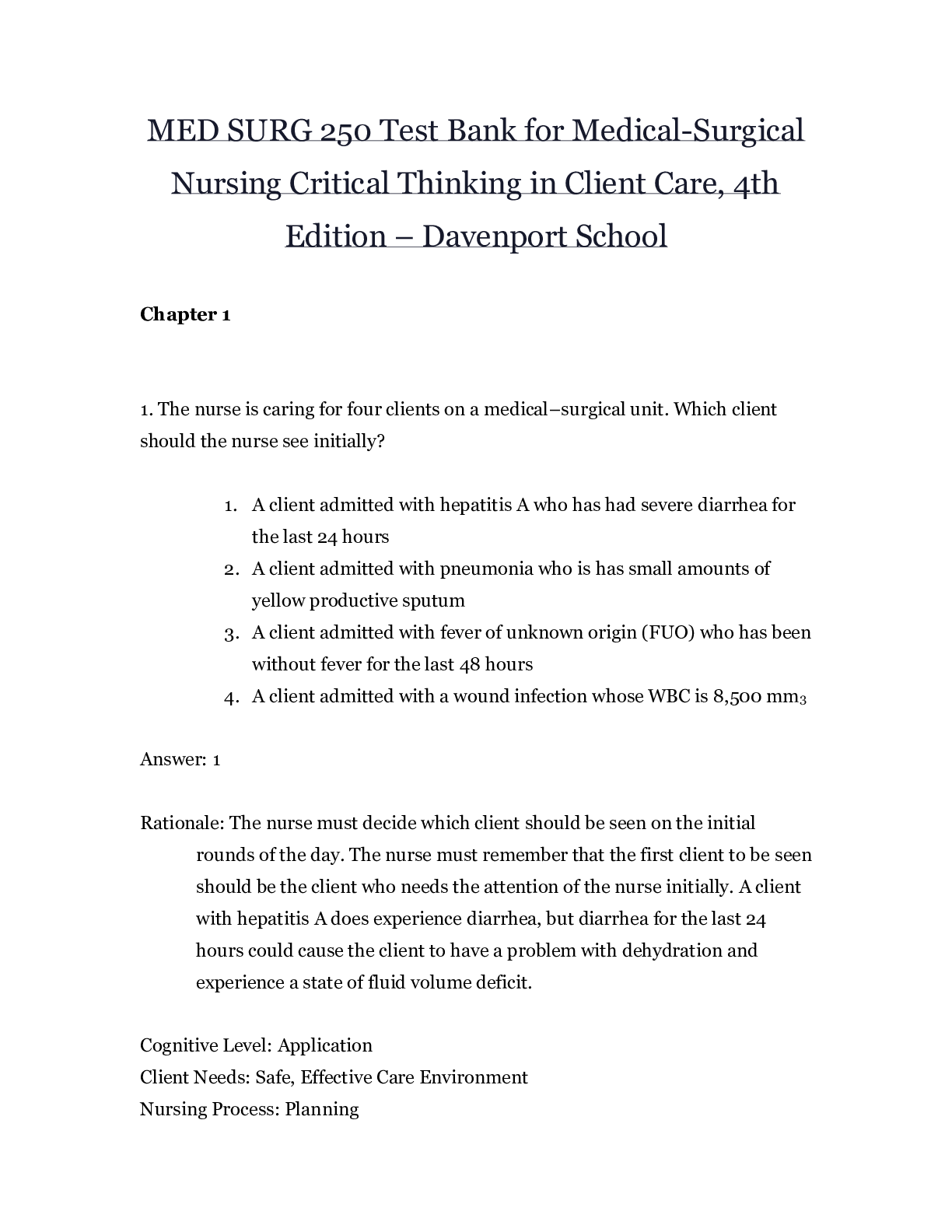
Buy this document to get the full access instantly
Instant Download Access after purchase
Buy NowInstant download
We Accept:

Reviews( 0 )
$24.50
Can't find what you want? Try our AI powered Search
Document information
Connected school, study & course
About the document
Uploaded On
Aug 20, 2020
Number of pages
443
Written in
Additional information
This document has been written for:
Uploaded
Aug 20, 2020
Downloads
0
Views
132








 – University of the People.png)
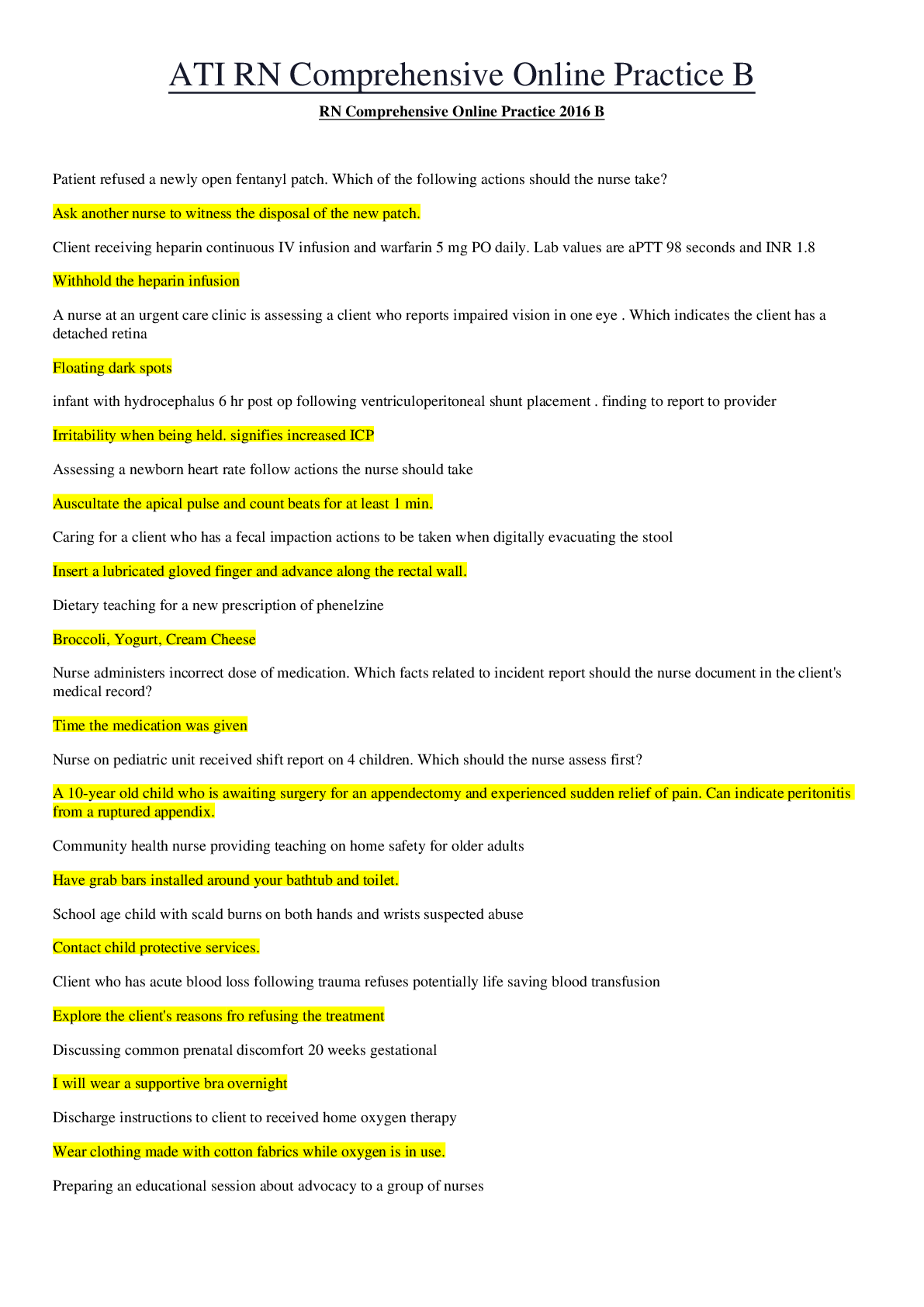



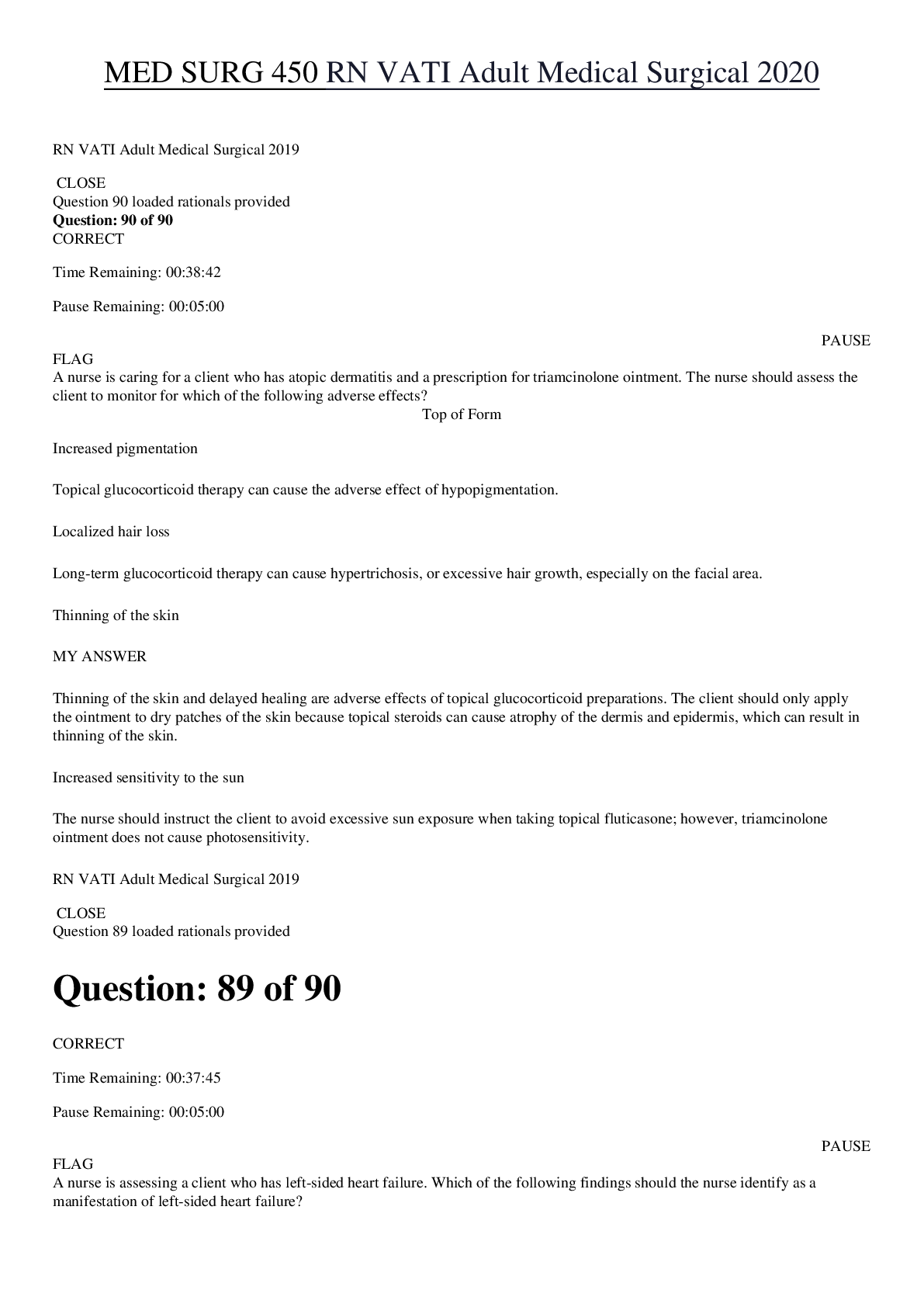
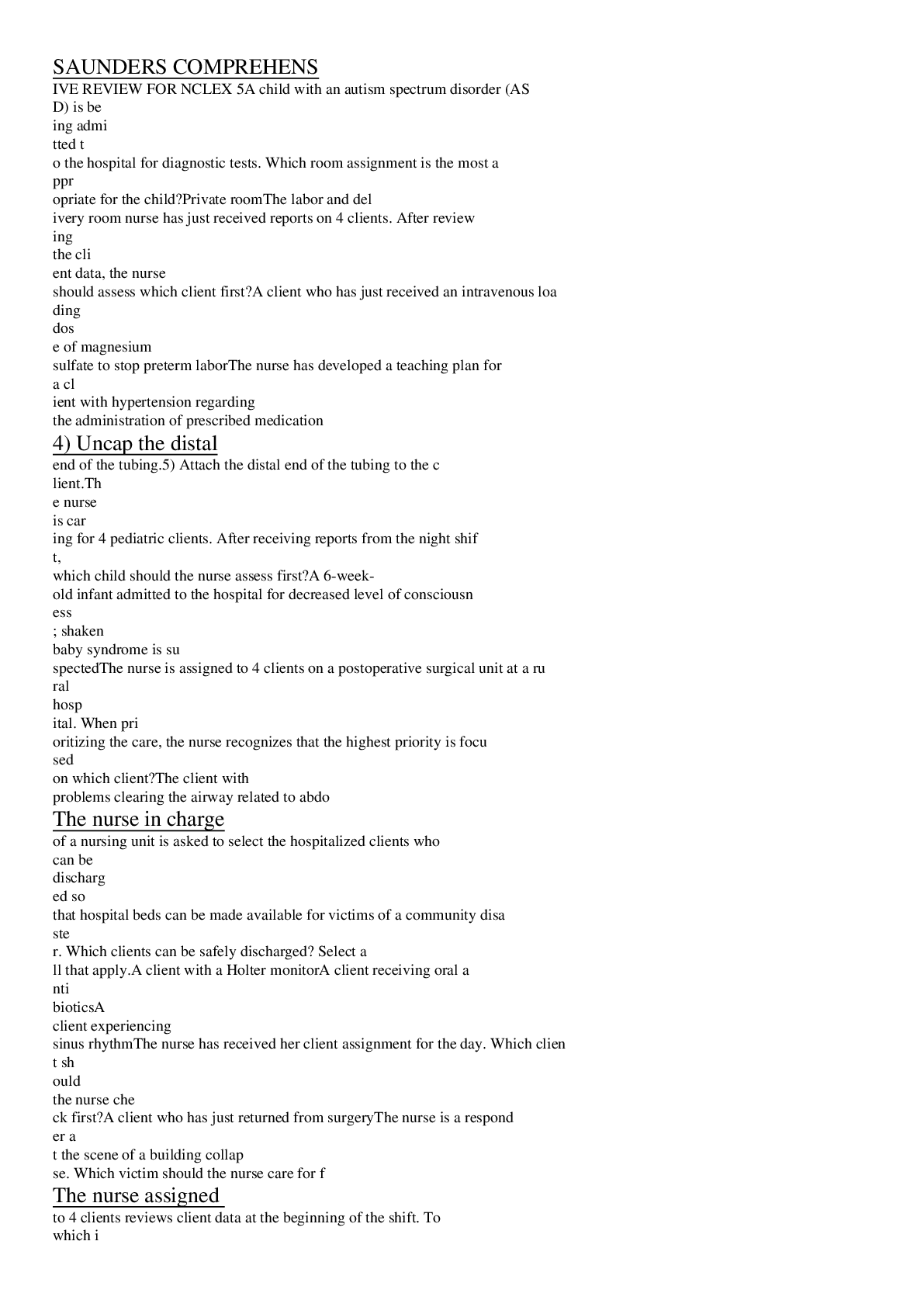
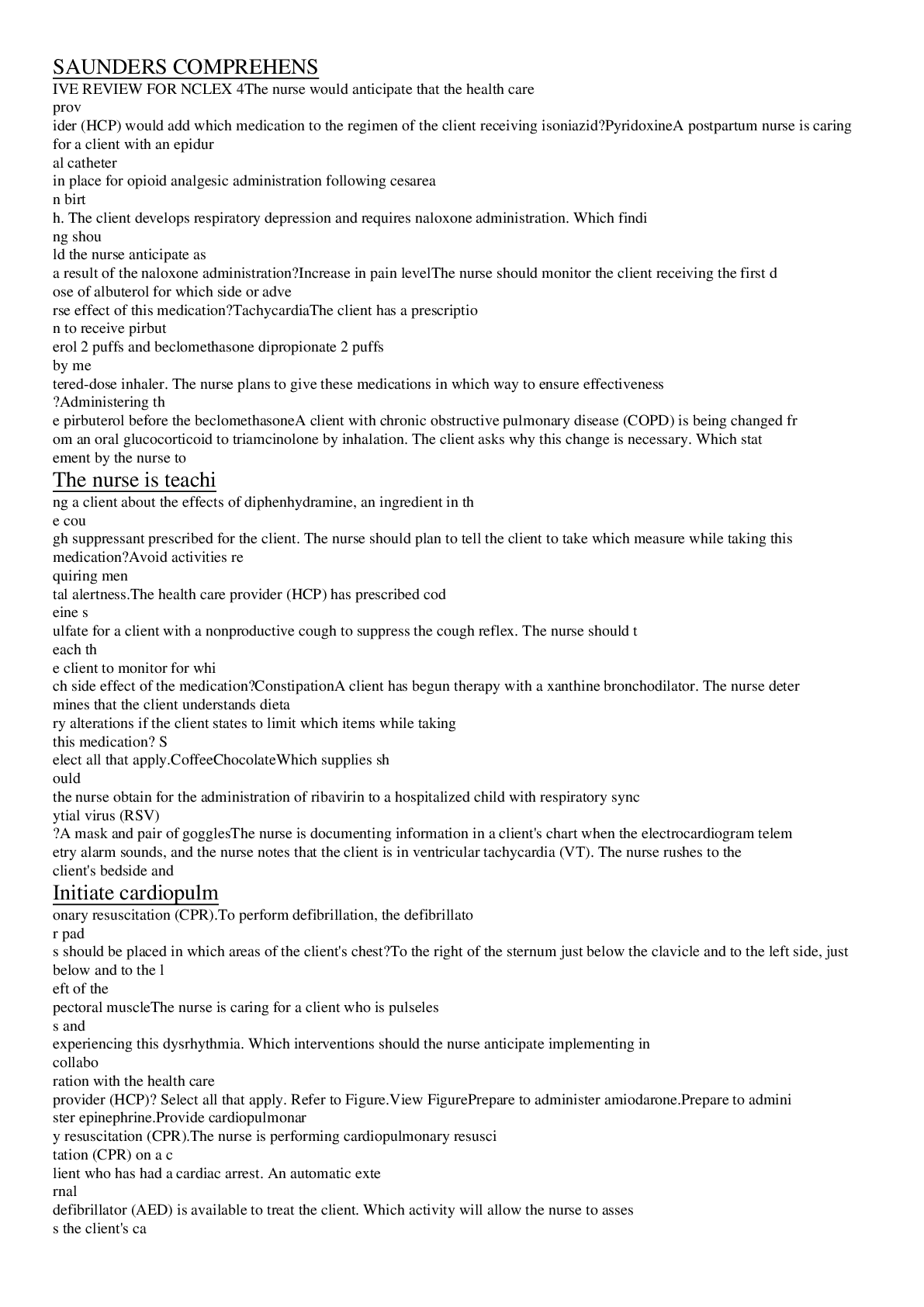
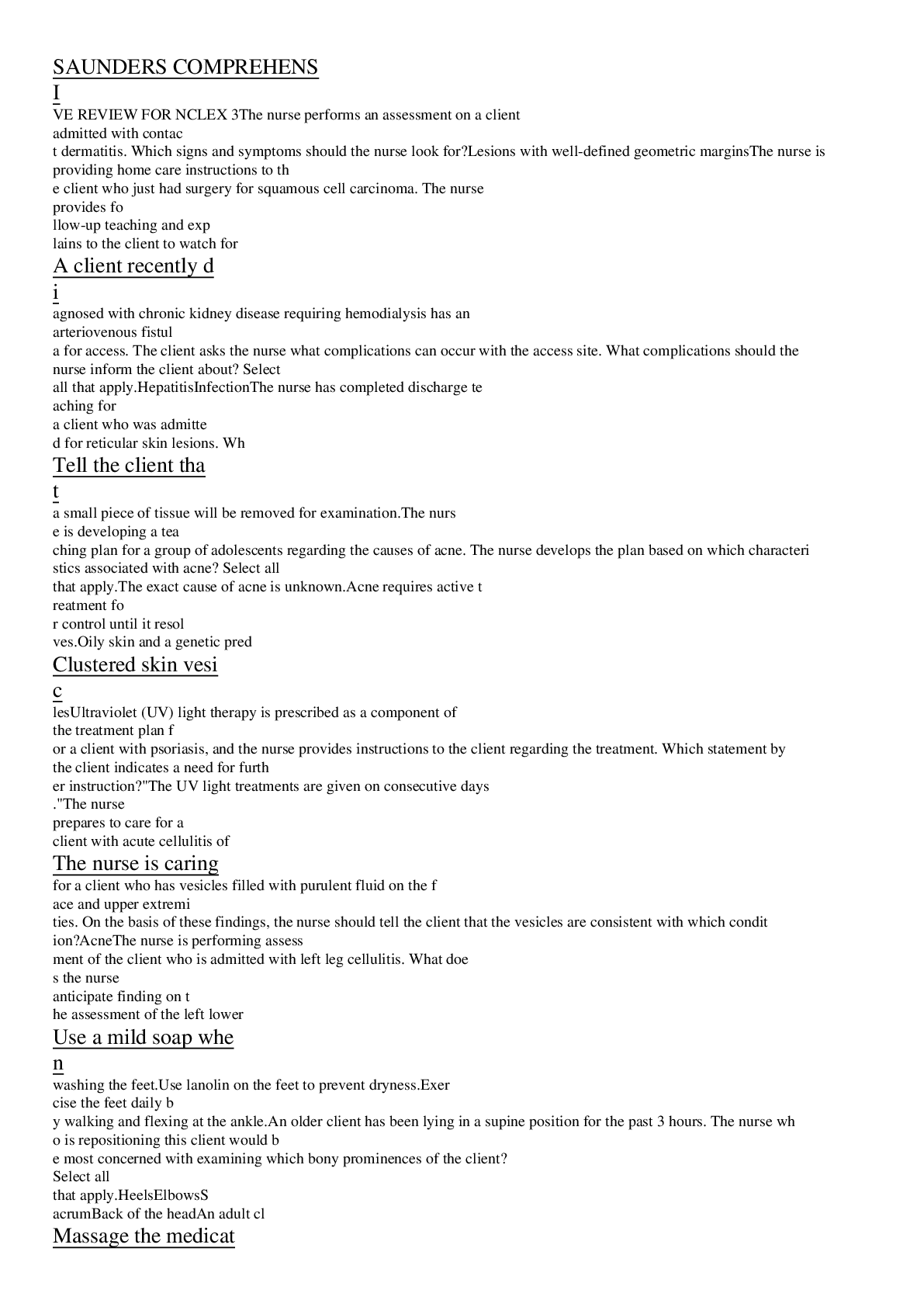
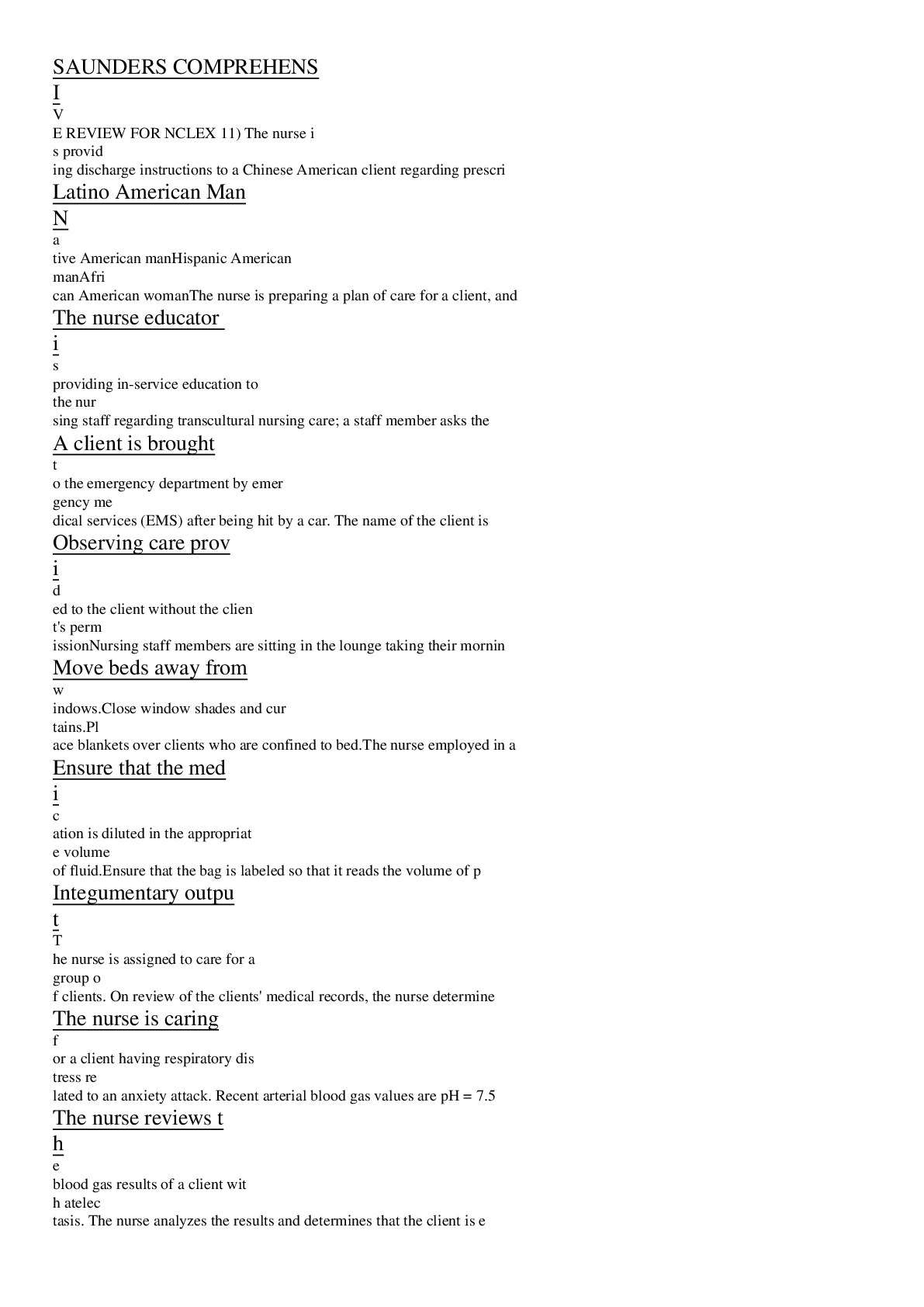
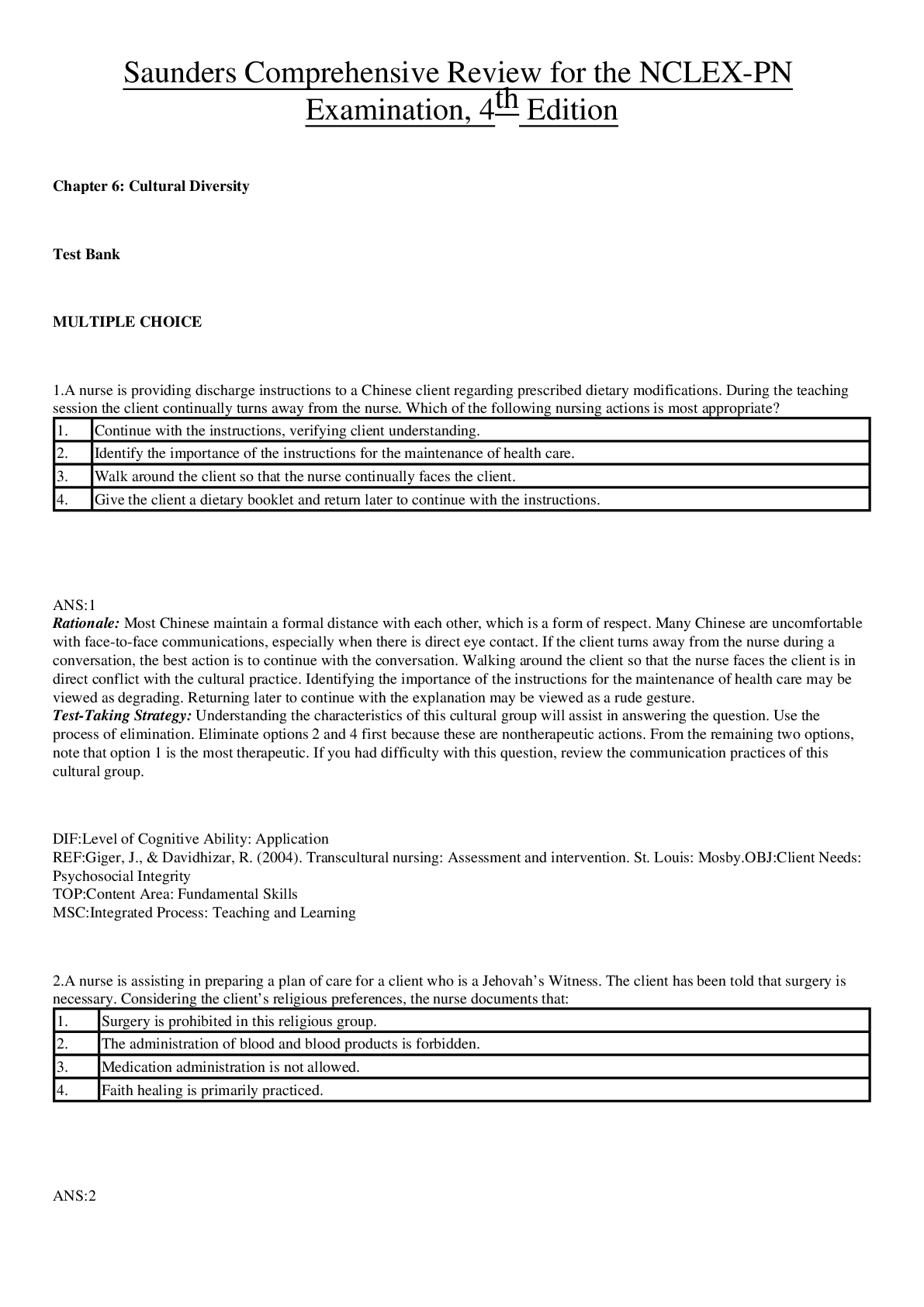
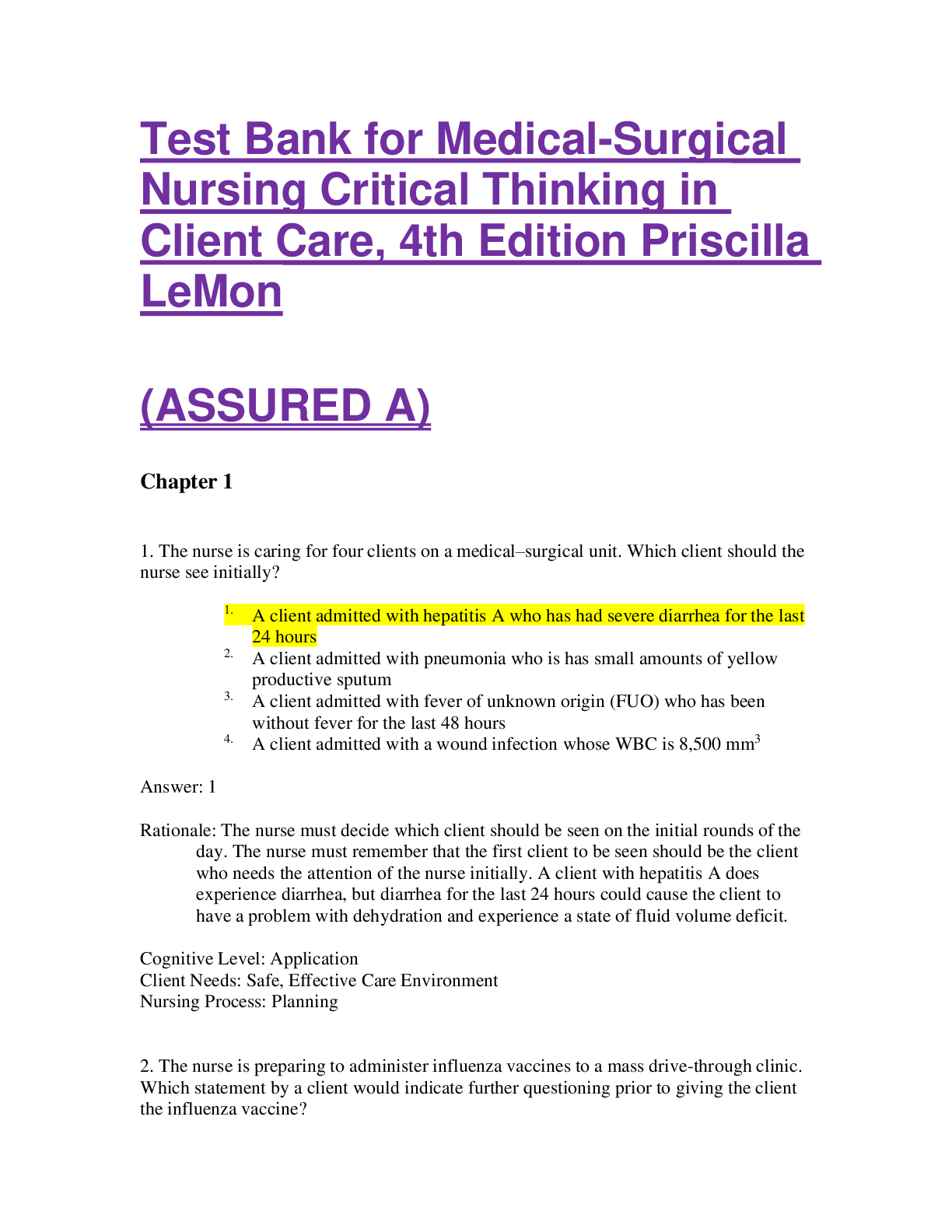

.png)
